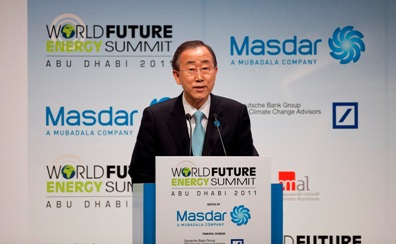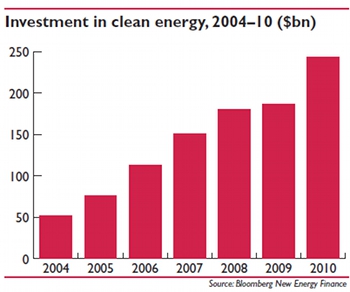A procession of the powerful took to the stage to open the World Future Energy Summit (WFES) yesterday in Abu Dhabi. Royalty and presidents, prime ministers and ministers, not to mention a headlining spot for UN Secretary-General Ban Ki-Moon.

Ban Ki-Moon: "Our challenge is transformation"
The annual summit is an opportunity for making connections between politicians and policy-makers with clean energy business leaders and investors – 3,150 delegates turned up on the first day, which WFES said was a 16% increase on last year, mingling and doing deals among the stands in Abu Dhabi’s gigantic exhibition hall, as well as attending a parallel programme of business- and technology-oriented side events.
What was said on the main stage, meanwhile, was largely what one might expect: there were no headline-grabbing announcements, with the emphasis instead on re-stating a commitment to clean energy, and on Abu Dhabi’s and the UAE’s emergence as a clean-tech and clean energy hub.
“Our challenge is transformation,” said Ki-Moon. “We need a global clean energy revolution.”
Adnen Amin, interim director general of the International Renewable Energy Agency, which is also based in Abu Dhabi, meanwhile spoke of the need for “an ambitious and transformative path to sustainability”.
In the plenary, the most interesting discussion in terms of fulfilling this hoped for revolution was among a battery of energy ministers, including from some key countries for the renewable energy business – notably China’s deputy energy minister Wu Yin and India’s minister of new and renewable energy Farooq Abdullah.
China is of course increasingly taking on the role of the leading light on clean energy, with its 12th five-year plan, due out in March, one of the most anticipated policy events of 2011.
Wu’s breakdown of the principal energy challenges the country faces will be no surprise to those following China’s energy story: security of supply, growing demand for energy, matching demand in the south and east with resources in the north and west. Consumption is on an upward path as well – but, as he reminded the audience, the country’s per capita energy consumption is still far behind the world average.
And to meet demand, the country is already consuming 3 billion tonnes of coal a year, which meets 70% of its primary energy needs, he said, via a translator (unfortunately your correspondent is not fluent), “so our greenhouse emissions are a big challenge for us”.
Sixty years after India’s independence, meanwhile, Abdullah noted that 40% of the population still lacks access to electricity. “That’s a major challenge.”
Senegal is facing a similar type of challenge, according to renewable energy minister Louis Seck, also speaking via a translator, with the need to leapfrog fossil fuels as remote areas are electrified. “We have huge potential of renewable energy, unfortunately this potential is not used in a proper way,” he said. Yet the country has set a target of 15% renewable energy by 2020 – and is the second nation after India to set up a dedicated ministry for renewables.
The question of how to pay for the transition to clean energy and low-carbon technologies, while grappling with the need many countries are facing to meet basic energy needs, was of course on the list of challenges as well.
Countries such as Senegal and India are setting renewable energy subsidies, but the question of keeping costs low is crucial.
Amina Benkhadra, minister of energy, mines water and environment in the Moroccan government, for example, said that the country’s ambitious plan to build 2GW of solar and 2GW of wind capacity will be partially financed by exporting some of the electricity to Europe, to tap the region’s feed-in tariffs.
Surely it is telling that the country is planning to export some of this electricity – although she did not put a figure on the amount – despite facing rocketing energy demand. Morocco is expecting its domestic energy demand to double by 2020 and triple by 2030, Benkhadra said.
India’s renewable energy minister, meanwhile, took the opportunity to pitch to the UAE to invest in the ministry’s proposed Green Bank: “At least we will not collapse like the American banks,” he joked. “We can give you better returns!”






